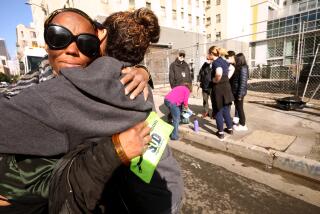Mission’s Goal Is Teaching Clients to Be Self-Sufficient : Recovery: The 23-year-old Oxnard-based rescue organization helps the down-and-out get on their feet without taxpayer funding.
- Share via
The tales of redemption are too many to count, the strung-out drifters nursed back to the straight life too many to remember.
At the Ventura County Rescue Mission, everyone has a story to tell.
Founded in 1972, the Oxnard-based organization, which operates thrift stores in Ventura and Oxnard, serves as soup kitchen, spiritual hub, homeless shelter, drug rehab and job-training center for the county’s down and out.
And many of the people who have devoted their lives to the Rescue Mission’s humanitarian cause--from the chaplains to the thrift-store employees--once found themselves before its well-worn doors, homeless or drug-addicted themselves.
The Rescue Mission has never accepted taxpayer money, surviving mostly with small donations, and employees encourage participants in its live-in drug and alcohol recovery program to shun government handouts.
“We tell them, ‘You’re going to live off of the government’s table or off of God’s table,’ ” said Jerry Roberg, the mission’s executive director for seven years. “ ‘Now which one is it going to be?’
“We want to create self-sufficient people, and that makes them feel good, because no one feels good about taking welfare.”
But some homeless men complain that the mission imposes its Christian views on them by demanding that they pray before meals. Others say it offers no dormitories for women, who are an increasing part of the homeless population.
“It’s a great place,” said a homeless man named Tom, waiting outside the mission for the noon meal. “It’s a good thing that it’s here. But women don’t have a place to go at night.”
Mission directors eventually hope to build a shelter for women and children but are proceeding with a men’s dormitory first.
Joe Thomas, a “graduate” of the mission’s live-in program, is now general manager of the mission’s thrift stores.
In what seems to him like a previous life, he once ran an auto-repair shop in Thousand Oaks. He was happily married and had only eight years left on his 30-year mortgage.
But he had a problem with alcohol and, eventually, heroin.
“I was your typical business-type drinker,” said Thomas, 46. “I had the same job for 23 years and I was married for 23 years. I lost them both.”
Thomas sank fast. He and his wife divorced, he spent $70,000 in one year, and before he knew it, found himself seriously ill at the Rescue Mission after emerging from a drug-stoked stupor. His sister had carried him to the door, hoping that the mission could help him before he died.
“When I came out of my haze, I realized [the mission] had a drug-rehabilitation program,” he said. “Lo and behold, I found out God was smarter than me.”
The experience saved his life, Thomas said, and now he has become a part of the mission family in more ways than one. His daughter and sister, both of whom had substance-abuse problems of their own, are married to graduates of the one-year program. His brother-in-law is a chaplain, and his son-in-law drives a truck for the mission.
They are among the 15% who survive the demanding rehabilitation routine, in which participants rise at 5:30 a.m., help prepare meals, attend hours of 12-step sessions and work well into the evening. And they belong to the estimated 90% who stay off drugs if they make it through.
About 30 men take part in the residential recovery program at a time, sharing tiny rooms in an old motel beside the mission.
The program is the Rescue Mission’s long-term component, designed to help those who vow to help themselves.
But the mission offers many other services for those not yet ready to make such commitments. It provided about 23,000 free articles of clothing, 35,000 free shaves and showers, and 125,000 free meals last year.
And although the mission’s dormitory burned down in 1992, the mission provided lodging for 44 men each night last year in two large tents beside its downtown Oxnard chapel.
Mission directors are working on a plan to build a two-story, 14,000-square-foot men’s dormitory, expand the dining and classroom facilities, and provide permanent medical and dental services. But money is scarce, and the proposal has yet to be approved by the Oxnard City Council.
Meanwhile, the thrift stores are thriving, selling everything from old Donny and Marie Osmond records to VCRs and fitness equipment. Four mission trucks constantly travel to neighborhoods throughout Ventura County, gathering thousands of garments and other salable goods.
Rick Cahill’s life was a shambles in 1990 when he arrived at the mission a hopeless cocaine addict.
“I was living out of my car, really depressed,” he said. “I had a job making $40,000 a year purchasing computers, but I got into cocaine. I didn’t really even like it, but there was a void in my life.”
Now he manages the mission’s business operations, and he attributes his recovery to the love he received from the mission chaplains.
“They filled that void with Jesus,” he said. “They told me I didn’t have to live in my car any more.”
Andy Anderson had been lying in a ditch in Santa Paula for several days, helplessly drunk, when a group of farm workers picked him up, threw him in the back of a pickup and dumped him at the mission, orange peels still stuck to his back.
He is now a mission chaplain and enjoys being a mentor to others who find themselves in similar shape.
But working at the mission is a bittersweet experience, he said. For each one who gets sober, there is someone who does not, and many of the men they meet are destined to die shortly afterward.
Thomas remembers one 33-year-old man he became close friends with. Thomas thought that the man was making a recovery, but he abruptly left the mission. Several weeks later, he was found dead of a heroin overdose in an abandoned warehouse.
“I’ve got a real heart for the guys, because I’ve been there,” Thomas said. “I know what it’s like to mess up.”
Ed, a participant in the recovery program, is trying to kick a 25-year heroin habit.
“I was in bad shape when I got here, and I was humiliated,” said Ed, who grew up in an affluent Malibu family. “I’d never been in a mission in my whole life, and I really thought I hit rock-bottom. But after I was here a while, I realized it was the right place for me to be.”
A 44-year-old with a wife in Ventura, Ed is in his last month of rehab, and he is doing well, working as the mission’s lunch cook.
Although he fell off the wagon for a few weeks when he first arrived at the mission, using heroin with one of the men at the shelter tents, he believes that he will now stay off drugs for good.
“I’m going to make it,” he said, beaming. “I do think I’m going to make it.”
More to Read
Sign up for Essential California
The most important California stories and recommendations in your inbox every morning.
You may occasionally receive promotional content from the Los Angeles Times.













